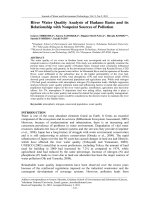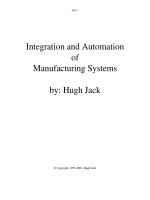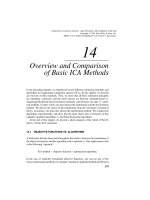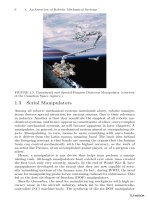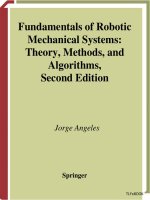real analysis measure theory integration and hilbert spaces shakarchi
Bạn đang xem bản rút gọn của tài liệu. Xem và tải ngay bản đầy đủ của tài liệu tại đây (2.35 MB, 423 trang )
REAL ANALYSIS
Ibookroot October 20, 2007
Princeton
Lectures
in
Analysis
I Fourier Analysis: An Introduction
II Complex Analysis
III Real Analysis:
Measure Theory, Integration, and
Hilbert Spaces
IV Functional Analysis: Introduction
to Further Topics in Analysis
Princeton Lectures in Analysis
III
REAL ANALYSIS
Measure Theory, Integration, and
Hilbert Spaces
Elias M. Stein
&
Rami Shakarchi
PRINCETON UNIVERSITY PRESS
PRINCETON AND OXFORD
Copyright © 2005 by Princeton University Press
Published by Princeton University Press, 41 William Street,
Princeton, New Jersey 08540
In the United Kingdom: Princeton University Press,
6 Oxford Street, Woodstock, Oxfordshire OX20 1TW
All Rights Reserved
Library of Congress Control Number 2004114065
ISBN 978-0-691-11386-9
British Library Cataloging-in-Publication Data is available
The publisher would like to acknowledge the authors of this volume for
providing the camera-ready copy from which this book was printed
Printed on acid-free paper. ∞
press.princeton.edu
Printed in the United States of America
5 7 9 10 8 6
43
To my grandchildren
Carolyn, Alison, Jason
E.M.S.
To my parents
Mohamed & Mireille
and my brother
Karim
R.S.
Foreword
Beginning in the spring of 2000, a series of four one-semester courses
were taught at Princeton University whose purpose was to present, in
an integrated manner, the core areas of analysis. The objective was to
make plain the organic unity that exists between the various parts of the
subject, and to illustrate the wide applicability of ideas of analysis to
other fields of mathematics and science. The present series of books is
an elaboration of the lectures that were given.
While there are a number of excellent texts dealing with individual
parts of what we cover, our exposition aims at a different goal: pre-
senting the various sub-areas of analysis not as separate disciplines, but
rather as highly interconnected. It is our view that seeing these relations
and their resulting synergies will motivate the reader to attain a better
understanding of the subject as a whole. With this outcome in mind, we
have concentrated on the main ideas and theorems that have shaped the
field (sometimes sacrificing a more systematic approach), and we have
been sensitive to the historical order in which the logic of the subject
developed.
We have organized our exposition into four volumes, each reflecting
the material covered in a semester. Their contents may be broadly sum-
marized as follows:
I. Fourier series and integrals.
II. Complex analysis.
III. Measure theory, Lebesgue integration, and Hilbert spaces.
IV. A selection of further topics, including functional analysis, distri-
butions, and elements of probability theory.
However, this listing does not by itself give a complete picture of
the many interconnections that are presented, nor of the applications
to other branches that are highlighted. To give a few examples: the ele-
ments of (finite) Fourier series studied in Book I, which lead to Dirichlet
characters, and from there to the infinitude of primes in an arithmetic
progression; the X-ray and Radon transforms, which arise in a number of
viii F OREWORD
problems in Book I, and reappear in Bo ok III to play an important role in
understanding Besicovitch-like sets in two and three dimensions; Fatou’s
theorem, which guarantees the existence of boundary values of bounded
holomorphic functions in the disc, and whose proof relies on ideas devel-
oped in each of the first three books; and the theta function, which first
occurs in Book I in the solution of the heat equation, and is then used
in Book II to find the number of ways an integer can be represented as
the sum of two or four squares, and in the analytic continuation of the
zeta function.
A few further words about the books and the courses on which they
were based. These courses where given at a rather intensive pace, with 48
lecture-hours a semester. The weekly problem sets played an indispens-
able part, and as a result exercises and problems have a similarly im-
portant role in our books. Each chapter has a series of “Exercises” that
are tied directly to the text, and while some are easy, others may require
more effort. However, the substantial number of hints that are given
should enable the reader to attack most exercises. There are also more
involved and challenging “Problems”; the ones that are most difficult, or
go beyond the scope of the text, are marked with an asterisk.
Despite the substantial connections that exist between the different
volumes, enough overlapping material has been provided so that each of
the first three books requires only minimal prerequisites: acquaintance
with elementary topics in analysis such as limits, series, differentiable
functions, and Riemann integration, together with some exposure to lin-
ear algebra. This makes these books accessible to students interested
in such diverse disciplines as mathematics, physics, engineering, and
finance, at both the undergraduate and graduate level.
It is with great pleasure that we express our appreciation to all who
have aided in this enterprise. We are particularly grateful to the stu-
dents who participated in the four courses. Their continuing interest,
enthusiasm, and dedication provided the encouragement that made this
project possible. We also wish to thank Adrian Banner and Jos´e Luis
Rodrigo for their special help in running the courses, and their efforts to
see that the students got the most from each class. In addition, Adrian
Banner also made valuable suggestions that are incorporated in the text.
F OREWORD ix
We wish also to record a note of special thanks for the following in-
dividuals: Charles Fefferman, who taught the first week (successfully
launching the whole project!); Paul Hagelstein, who in addition to read-
ing part of the manuscript taught several weeks of one of the courses, and
has since taken over the teaching of the second round of the series; and
Daniel Levine, who gave valuable help in proof-reading. Last but not
least, our thanks go to Gerree Pecht, for her consummate skill in type-
setting and for the time and energy she spent in the preparation of all
aspects of the lectures, such as transparencies, notes, and the manuscript.
We are also happy to acknowledge our indebtedness for the support
we received from the 250th Anniversary Fund of Princeton University,
and the National Science Foundation’s VIGRE program.
Elias M. Stein
Rami Shakarchi
Princeton, New Jersey
August 2002
In this third volume we establish the basic facts concerning measure
theory and integration. This allows us to reexamine and develop further
several important topics that arose in the previous volumes, as well as to
introduce a number of other subjects of substantial interest in analysis.
To aid the interested reader, we have starred sections that contain more
advanced material. These can be omitted on first reading. We also want
to take this opportunity to thank Daniel Levine for his continuing help in
proof-reading and the many suggestions he made that are incorporated
in the text.
November 2004
Contents
Foreword vii
Introduction xv
1 Fourier series: completion xvi
2 Limits of continuous functions xvi
3 Length of curves xvii
4 Differentiation and integration xviii
5 The problem of measure xviii
Chapter 1. Measure Theory 1
1 Preliminaries 1
2 The exterior measure 10
3 Measurable sets and the Lebesgue measure 16
4 Measurable functions 27
4.1 Definition and basic properties 27
4.2 Approximation by simple functions or step functions 30
4.3 Littlewood’s three principles 33
5* The Brunn-Minkowski inequality 34
6 Exercises 37
7 Problems 46
Chapter 2. Integration Theory 49
1 The Lebesgue integral: basic properties and convergence
theorems 49
2 The space L
1
of integrable functions 68
3 Fubini’s theorem 75
3.1 Statement and proof of the theorem 75
3.2 Applications of Fubini’s theorem 80
4* A Fourier inversion formula 86
5 Exercises 89
6 Problems 95
Chapter 3. Differentiation and Integration 98
1 Differentiation of the integral 99
1.1 The Hardy-Littlewood maximal function 100
1.2 The Lebesgue differentiation theorem 104
2 Good kernels and approximations to the identity 108
xi
xii CONTENTS
3 Differentiability of functions 114
3.1 Functions of bounded variation 115
3.2 Absolutely continuous functions 127
3.3 Differentiability of jump functions 131
4 Rectifiable curves and the isoperimetric inequality 134
4.1* Minkowski content of a curve 136
4.2* Isoperimetric inequality 143
5 Exercises 145
6 Problems 152
Chapter 4. Hilbert Spaces: An Introduction 156
1 The Hilb ert space L
2
156
2 Hilbert spaces 161
2.1 Orthogonality 164
2.2 Unitary mappings 168
2.3 Pre-Hilbert spaces 169
3 Fourier series and Fatou’s theorem 170
3.1 Fatou’s theorem 173
4 Closed subspaces and orthogonal projections 174
5 Linear transformations 180
5.1 Linear functionals and the Riesz representation the-
orem 181
5.2 Adjoints 183
5.3 Examples 185
6 Compact op erators 188
7 Exercises 193
8 Problems 202
Chapter 5. Hilbert Spaces: Several Examples 207
1 The Fourier transform on L
2
207
2 The Hardy space of the upper half-plane 213
3 Constant coefficient partial differential equations 221
3.1 Weak solutions 222
3.2 The main theorem and key estimate 224
4* The Dirichlet principle 229
4.1 Harmonic functions 234
4.2 The boundary value problem and Dirichlet’s principle 243
5 Exercises 253
6 Problems 259
CONTENTS xiii
Chapter 6. Abstract Measure and Integration Theory 262
1 Abstract measure spaces 263
1.1 Exterior measures and Carath´eodory’s theorem 264
1.2 Metric exterior measures 266
1.3 The extension theorem 270
2 Integration on a measure space 273
3 Examples 276
3.1 Product measures and a general Fubini theorem 276
3.2 Integration formula for polar coordinates 279
3.3 Borel measures on R and the Lebesgue-Stieltjes in-
tegral 281
4 Absolute continuity of measures 285
4.1 Signed measures 285
4.2 Absolute continuity 288
5* Ergodic theorems 292
5.1 Mean ergodic theorem 294
5.2 Maximal ergodic theorem 296
5.3 Pointwise ergodic theorem 300
5.4 Ergodic measure-preserving transformations 302
6* Appendix: the spectral theorem 306
6.1 Statement of the theorem 306
6.2 Positive operators 307
6.3 Proof of the theorem 309
6.4 Spectrum 311
7 Exercises 312
8 Problems 319
Chapter 7. Hausdorff Measure and Fractals 323
1 Hausdorff measure 324
2 Hausdorff dimension 329
2.1 Examples 330
2.2 Self-similarity 341
3 Space-filling curves 349
3.1 Quartic intervals and dyadic squares 351
3.2 Dyadic correspondence 353
3.3 Construction of the Peano mapping 355
4* Besicovitch sets and regularity 360
4.1 The Radon transform 363
4.2 Regularity of sets when d ≥ 3 370
4.3 Besicovitch sets have dimension 2 371
4.4 Construction of a Besicovitch set 374
xiv CONTENTS
5 Exercises 380
6 Problems 385
Notes and References 389
Bibliography 391
Symbol Glossary 395
Index 397
Introduction
I turn away in fright and horror from this lamentable
plague of functions that do not have derivatives.
C. Hermite, 1893
Starting in about 1870 a revolutionary change in the conceptual frame-
work of analysis began to take shape, one that ultimately led to a vast
transformation and generalization of the understanding of such basic ob-
jects as functions, and such notions as continuity, differentiability, and
integrability.
The earlier view that the relevant functions in analysis were given by
formulas or other “analytic” expressions, that these functions were by
their nature continuous (or nearly so), that by necessity such functions
had derivatives for most points, and moreover these were integrable by
the accepted methods of integration − all of these ideas began to give
way under the weight of various examples and problems that arose in
the subject, which could not be ignored and required new concepts to
be understood. Parallel with these developments came new insights that
were at once both more geometric and more abstract: a clearer under-
standing of the nature of curves, their rectifiability and their extent; also
the beginnings of the theory of sets, starting with subsets of the line, the
plane, etc., and the “measure” that could be assigned to each.
That is not to say that there was not considerable resistance to the
change of point-of-view that these advances required. Paradoxically,
some of the leading mathematicians of the time, those who should have
been best able to appreciate the new departures, were among the ones
who were most skeptical. That the new ideas ultimately won out can
be understood in terms of the many questions that could now be ad-
dressed. We shall describe here, somewhat imprecisely, several of the
most significant such problems.
xv
xvi INTRODUCTION
1 Fourier series: completion
Whenever f is a (Riemann) integrable function on [−π, π] we defined in
Book I its Fourier series f ∼
a
n
e
inx
by
(1) a
n
=
1
2π
π
−π
f(x)e
−inx
dx,
and saw then that one had Parseval’s identity,
∞
n=−∞
|a
n
|
2
=
1
2π
π
−π
|f(x)|
2
dx.
However, the above relationship between functions and their Fourier
coefficients is not completely reciprocal when limited to Riemann inte-
grable functions. Thus if we consider the space R of such functions with
its square norm, and the space
2
(Z) with its norm,
1
each element f in
R assigns a corresponding element {a
n
} in
2
(Z), and the two norms are
identical. However, it is easy to construct elements in
2
(Z) that do not
correspond to functions in R. Note also that the space
2
(Z) is complete
in its norm, while R is not.
2
Thus we are led to two questions:
(i) What are the putative “functions” f that arise when we complete
R? In other words: given an arbitrary sequence {a
n
} ∈
2
(Z) what
is the nature of the (presumed) function f corresponding to these
coefficients?
(ii) How do we integrate such functions f (and in particular verify (1))?
2 Limits of continuous functions
Suppose {f
n
} is a sequence of continuous functions on [0, 1]. We assume
that lim
n→∞
f
n
(x) = f (x) exists for every x, and inquire as to the nature
of the limiting function f.
If we suppose that the convergence is uniform, matters are straight-
forward and f is then everywhere continuous. However, once we drop
the assumption of uniform convergence, things may change radically and
the issues that arise can be quite subtle. An example of this is given by
the fact that one can construct a sequence of continuous functions {f
n
}
converging everywhere to f so that
1
We use the notation of Chapter 3 in Book I.
2
See the discussion surrounding Theorem 1.1 in Section 1, Chapter 3 of Book I.
3. Length of curves xvii
(a) 0 ≤ f
n
(x) ≤ 1 for all x.
(b) The sequence f
n
(x) is montonically decreasing as n → ∞.
(c) The limiting function f is not Riemann integrable.
3
However, in view of (a) and (b), the sequence
1
0
f
n
(x) dx converges to
a limit. So it is natural to ask: what method of integration can be used
to integrate f and obtain that for it
1
0
f(x) dx = lim
n→∞
1
0
f
n
(x) dx ?
It is with Lebesgue integration that we can solve both this problem
and the previous one.
3 Length of curves
The study of curves in the plane and the calculation of their lengths
are among the first issues dealt with when one learns calculus. Suppose
we consider a continuous curve Γ in the plane, given parametrically by
Γ = {(x(t), y(t))}, a ≤ t ≤ b, with x and y continuous functions of t. We
define the length of Γ in the usual way: as the supremum of the lengths
of all polygonal lines joining successively finitely many points of Γ, taken
in order of increasing t. We say that Γ is rectifiable if its length L is
finite. When x(t) and y(t) are continuously differentiable we have the
well-known formula,
(2) L =
b
a
(x
(t))
2
+ (y
(t))
2
1/2
dt.
The problems we are led to arise when we consider general curves.
More specifically, we can ask:
(i) What are the conditions on the functions x(t) and y(t) that guar-
antee the rectifiability of Γ?
(ii) When these are satisfied, does the formula (2) hold?
The first question has a complete answer in terms of the notion of func-
tions of “bounded variation.” As to the second, it turns out that if x and
y are of bounded variation, the integral (2) is always meaningful; how-
ever, the equality fails in general, but can be restored under appropriate
reparametrization of the curve Γ.
3
The limit f can be highly discontinuous. See, for instance, Exercise 10 in Chapter 1.
xviii INTRODUCTION
There are further issues that arise. Rectifiable curves, because they
are endowed with length, are genuinely one-dimensional in nature. Are
there (non-rectifiable) curves that are two-dimensional? We shall see
that, indeed, there are continuous curves in the plane that fill a square,
or more generally have any dimension between 1 and 2, if the notion of
fractional dimension is appropriately defined.
4 Differentiation and integration
The so-called “fundamental theorem of the calculus” expresses the fact
that differentiation and integration are inverse operations, and this can
be stated in two different ways, which we abbreviate as follows:
(3) F (b) −F (a) =
b
a
F
(x) dx,
(4)
d
dx
x
0
f(y) dy = f(x).
For the first assertion, the existence of continuous functions F that are
nowhere differentiable, or for which F
(x) exists for every x, but F
is
not integrable, leads to the problem of finding a general class of the F for
which (3) is valid. As for (4), the question is to formulate properly and
establish this assertion for the general class of integrable functions f that
arise in the solution of the first two problems considered above. These
questions can b e answered with the help of certain “covering” arguments,
and the notion of absolute continuity.
5 The problem of measure
To put matters clearly, the fundamental issue that must be understood
in order to try to answer all the questions raised above is the problem
of measure. Stated (imprecisely) in its version in two dimensions, it
is the problem of assigning to each subset E of R
2
its two-dimensional
measure m
2
(E), that is, its “area,” extending the standard notion defined
for elementary sets. Let us instead state more precisely the analogous
problem in one dimension, that of constructing one-dimensional measure
m
1
= m, which generalizes the notion of length in R.
We are looking for a non-negative function m defined on the family of
subsets E of R that we allow to be extended-valued, that is, to take on
the value +∞. We require:
5. The problem of measure xix
(a) m(E) = b −a if E is the interval [a, b], a ≤ b, of length b −a.
(b) m(E) =
∞
n=1
m(E
n
) whenever E =
∞
n=1
E
n
and the sets E
n
are
disjoint.
Condition (b) is the “countable additivity” of the measure m. It implies
the special case:
(b
) m(E
1
∪ E
2
) = m(E
1
) + m(E
2
) if E
1
and E
2
are disjoint.
However, to apply the many limiting arguments that arise in the theory
the general case (b) is indispensable, and (b
) by itself would definitely
be inadequate.
To the axioms (a) and (b) one adds the translation-invariance of m,
namely
(c) m(E + h) = m(E), for every h ∈ R.
A basic result of the theory is the existence (and uniqueness) of such
a measure, Leb esgue measure, when one limits oneself to a class of rea-
sonable sets, those which are “measurable.” This class of sets is closed
under countable unions, intersections, and complements, and contains
the open sets, the closed sets, and so forth.
4
It is with the construction of this measure that we begin our study.
From it will flow the general theory of integration, and in particular the
solutions of the problems discussed ab ove.
A chronology
We conclude this introduction by listing some of the signal events that
marked the early development of the subject.
1872 − Weierstrass’s construction of a nowhere differentiable function.
1881 − Introduction of functions of bounded variation by Jordan and
later (1887) connection with rectifiability.
1883 − Cantor’s ternary set.
1890 − Construction of a space-filling curve by Peano.
1898 − Borel’s measurable sets.
1902 − Leb esgue’s theory of measure and integration.
1905 − Construction of non-measurable sets by Vitali.
1906 − Fatou’s application of Lebesgue theory to complex analysis.
4
There is no such measure on the class of all subsets, since there exist non-measurable
sets. See the construction of such a set at the end of Section 3, Chapter 1.
1 Measure Theory
The sets whose measure we can define by virtue of the
preceding ideas we will call measurable sets; we do
this without intending to imply that it is not possible
to assign a measure to other sets.
E. Borel, 1898
This chapter is devoted to the construction of Lebesgue measure in R
d
and the study of the resulting class of measurable functions. After some
preliminaries we pass to the first important definition, that of exterior
measure for any subset E of R
d
. This is given in terms of approximations
by unions of cubes that cover E. With this notion in hand we can
define measurability and thus restrict consideration to those sets that
are measurable. We then turn to the fundamental result: the collection
of measurable sets is closed under complements and countable unions,
and the measure is additive if the subsets in the union are disjoint.
The concept of measurable functions is a natural outgrowth of the
idea of measurable sets. It stands in the same relation as the concept
of continuous functions does to open (or closed) sets. But it has the
important advantage that the class of measurable functions is closed
under pointwise limits.
1 Preliminaries
We begin by discussing some elementary concepts which are basic to the
theory developed below.
The main idea in calculating the “volume” or “measure” of a subset
of R
d
consists of approximating this set by unions of other sets whose
geometry is simple and whose volumes are known. It is convenient to
speak of “volume” when referring to sets in R
d
; but in reality it means
“area” in the case d = 2 and “length” in the case d = 1. In the approach
given here we shall use rectangles and cubes as the main building blocks
of the theory: in R we use intervals, while in R
d
we take products of
intervals. In all dimensions rectangles are easy to manipulate and have
a standard notion of volume that is given by taking the product of the
length of all sides.
2 Chapter 1. MEASURE THEORY
Next, we prove two simple theorems that highlight the importance of
these rectangles in the geometry of open sets: in R every open set is a
countable union of disjoint open intervals, while in R
d
, d ≥ 2, every open
set is “almost” the disjoint union of closed cubes, in the sense that only
the boundaries of the cubes can overlap. These two theorems motivate
the definition of exterior measure given later.
We shall use the following standard notation. A point x ∈ R
d
consists
of a d-tuple of real numbers
x = (x
1
, x
2
, . . . , x
d
), x
i
∈ R, for i = 1, . . . , d.
Addition of points is componentwise, and so is multiplication by a real
scalar. The norm of x is denoted by | x| and is defined to be the standard
Euclidean norm given by
|x| =
x
2
1
+ ···+ x
2
d
1/2
.
The distance b etween two points x and y is then simply |x −y|.
The complement of a set E in R
d
is denoted by E
c
and defined by
E
c
= {x ∈ R
d
: x /∈ E}.
If E and F are two subsets of R
d
, we denote the complement of F in E
by
E − F = {x ∈ R
d
: x ∈ E and x /∈ F }.
The distance b etween two sets E and F is defined by
d(E, F ) = inf |x −y|,
where the infimum is taken over all x ∈ E and y ∈ F .
Open, closed, and compact sets
The open ball in R
d
centered at x and of radius r is defined by
B
r
(x) = {y ∈ R
d
: |y − x| < r}.
A subset E ⊂ R
d
is open if for every x ∈ E there exists r > 0 with
B
r
(x) ⊂ E. By definition, a set is closed if its complement is open.
We note that any (not necessarily countable) union of open sets is
open, while in general the intersection of only finitely many open sets
1. Preliminaries 3
is open. A similar statement holds for the class of closed sets, if one
interchanges the roles of unions and intersections.
A set E is bounded if it is contained in some ball of finite radius.
A bounded set is compact if it is also closed. Compact sets enjoy the
Heine-Borel covering property:
• Assume E is compact, E ⊂
α
O
α
, and each O
α
is open. Then
there are finitely many of the open sets, O
α
1
, O
α
2
, . . . , O
α
N
, such
that E ⊂
N
j=1
O
α
j
.
In words, any covering of a compact set by a collection of open sets
contains a finite subcovering.
A point x ∈ R
d
is a limit point of the set E if for every r > 0, the ball
B
r
(x) contains points of E. This means that there are points in E which
are arbitrarily close to x. An isolated point of E is a p oint x ∈ E such
that there exists an r > 0 where B
r
(x) ∩E is equal to {x}.
A point x ∈ E is an interior point of E if there exists r > 0 such
that B
r
(x) ⊂ E. The set of all interior points of E is called the interior
of E. Also, the closure E of the E consists of the union of E and all
its limit points. The boundary of a set E, denoted by ∂E, is the set of
points which are in the closure of E but not in the interior of E.
Note that the closure of a set is a closed set; every point in E is a
limit point of E; and a set is closed if and only if it contains all its limit
points. Finally, a closed set E is perfect if E does not have any isolated
points.
Rectangles and cubes
A (closed) rectangle R in R
d
is given by the product of d one-dimensional
closed and bounded intervals
R = [a
1
, b
1
] ×[a
2
, b
2
] ×···× [a
d
, b
d
],
where a
j
≤ b
j
are real numbers, j = 1, 2, . . . , d. In other words, we have
R = {(x
1
, . . . , x
d
) ∈ R
d
: a
j
≤ x
j
≤ b
j
for all j = 1 , 2, . . . , d}.
We remark that in our definition, a rectangle is closed and has sides
parallel to the coordinate axis. In R, the rectangles are precisely the
closed and bounded intervals, while in R
2
they are the usual four-sided
rectangles. In R
3
they are the closed parallelepipeds.
We say that the lengths of the sides of the rectangle R are b
1
−
a
1
, . . . , b
d
− a
d
. The volume of the rectangle R is denoted by |R|, and
4 Chapter 1. MEASURE THEORY
R
2
R
R
3
Figure 1. Rectangles in R
d
, d = 1, 2, 3
is defined to be
|R| = (b
1
− a
1
) ···(b
d
− a
d
).
Of course, when d = 1 the “volume” equals length, and when d = 2 it
equals area.
An open rectangle is the product of open intervals, and the interior of
the rectangle R is then
(a
1
, b
1
) ×(a
2
, b
2
) ×···× (a
d
, b
d
).
Also, a cube is a rectangle for which b
1
− a
1
= b
2
− a
2
= ··· = b
d
− a
d
.
So if Q ⊂ R
d
is a cube of common side length , then |Q| =
d
.
A union of rectangles is said to be almost disjoint if the interiors of
the rectangles are disjoint.
In this chapter, coverings by rectangles and cubes play a major role,
so we isolate here two important lemmas.
Lemma 1.1 If a rectangle is the almost disjoint union of finitely many
other rectangles, say R =
N
k=1
R
k
, then
|R| =
N
k=1
|R
k
|.
